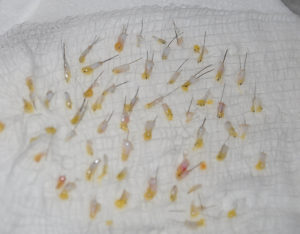Eyebrows occupy a very visible location on one’s face and are critical to the appearance of the eye area. They frame the eye and serve as an important aesthetic landmark between the eye and the frontal scalp hairline. Significant loss or changes in eyebrow hair density are usually very noticeable and can be quite troubling. While eyebrow shapes and styles change over the years, thin or sparse eyebrows are not usually aesthetically desireable.
Hair transplants to the eyebrows can be done for both men and women. While most commonly done for eyebrows lost due to injury (lacerations, avulsions, burns), disease (alopecia areata, trichilomania), or age (thinningof the hair) it may also be done for cosmetic enhancement (thickening of the eyebrow and/or extension of the tail) as well. Thin eyebrows in women occur from a congenital thinness and limited ability for the eyebrows to grow or loss of eyebrow hairs due to excessive plucking.
Tattooing of the lost or thin eyebrow is a very common technique that is simple and relatively quick to do with an immediate result. Unfortunately, eyebrow tattoos if not done professionally with good technique can look very unnatural with less than ideal color matches. Over time the tattoo will have some fading, which will require some touchups or long-term maintenance. Eyebrow tattoos essentially can not be removed. If unhappy with an eyebrow tattoo result, hair transplants can be done right into the tattooed skin.

Placement and proper angulation of the hairs is the key to a good, natural-looking eyebrow transplant. The eyebrow has hairs that have unique orientations in different parts of the eyebrow. The hair in the upper part of the middle of the eyebrow points upward to the hairline, while the hair on the tail will usually point towards the ears. The eyebrow hairs are also oriented much like a feather with the upper part of the eyebrow pointed slightly downward and the lower portion slightly upward forming a slight ridge.
Eyebrow hair transplantation may require more than one session of grafting to get the best results. Not all follicles completely survive each grafting session and optimal density of the eyebrow may require a second set of grafts. My goal is to get the best result in one session, not two, but hair transplant growth and density is not completely predictable. Second graft sessions are not done for six months after the first to give optimal time for the hair to grow and for the patient to adjust to the changes in the appearance of the eyebrow.
The hair used for eyebrow transplants comes from the scalp. Because most scalp hairs are more coarse than fine eyebrow hairs, the donor site is usually taken from the scalp hair right abobe or behind the ear. Scalp hair in this area is thinner and a better match for the eyebrows. Each eyebrow usually requires about 50 to 75 hair transplants, sometimes up to more than 100 per eyebrow depending upon the goals of the patient. These hair transplants, like the rest of the scalp, will continue to grow for the rest of your life and will need to be trimmed regularly. Over time, the transplanted scalp hairs will take on some of the characteristics of eyebrow hairs and growth will slow down. (eyebrow hair grow is about half that of scalp hairs)
Be aware that although the eyebrow hair transplants will be seen immediately after the procedure, the hair shaft attached to the follicle will fall out. In essence, follicle transplants are being done and the hair shaft is a good handle to place them. The hair shaft will quickly shed leaving the eyebrow looking like it did before the procedure. Hair growth from the follicle will require at least 3 months to become visible again and up to 6 to 9 months to grow in and see the final results.
There is no significant recovery from the procedure other than some crusting of the eyebrows and occasionally some slight upper eyelid swelling or bruising. There are no dressings used on the eyebrows other than ointment to keep them moist for the first few days. One can usually return to work within a few days.
As one can see, eyebrow hair transplants require much greater commitment and patience than eyebrow tattooing methods. But if one is looking for the most natural eyebrow result, particularly in a young person, eyebrow hair transplants may be a good long-term solution.
Dr. Barry Eppley
Indianapolis, Indiana


